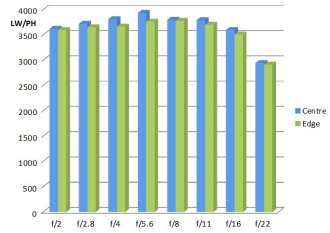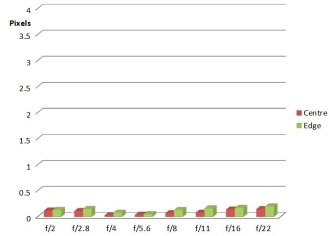Zeiss Milvus 135mm f/2.0 Review
Zeiss Milvus 135mm f/2.0 Performance
Central sharpness is excellent all the way from f/2 to f/16, touching on outstanding at the peak of f/5.6. It is still very good at f/22, making the inclusion of the smallest aperture meaningful as it can be used with confidence.
The edges are also excellent from f/2 to f/16, just dropping to very good at f/22.
How to read our charts
The blue column represents readings from the centre of the picture frame at the various apertures and the green is from the edges.The scale on the left side is an indication of actual image resolution as LW/PH and is described in detail above. The taller the column, the better the lens performance.
For this review, the lens was tested on a Nikon D810 using Imatest.
CA (Chromatic Aberration) is very low indeed, and should be with a lens described as apochromatic. This means that all three colours of light (RGB) are fully corrected for and will focus on the same point. Hence there will be no fringing. Of course, some lenses perform better than others and this Zeiss Milvus lens is as near to fully corrected as we could hope. There will be no need for any further correction in software.
How to read our charts
Chromatic aberration is the lens' inability to focus on the sensor or film all colours of visible light at the same point. Severe chromatic aberration gives a noticeable fringing or a halo effect around sharp edges within the picture. It can be cured in software.Apochromatic lenses have special lens elements (aspheric, extra-low dispersion etc) to minimize the problem, hence they usually cost more.
For this review, the lens was tested on a Nikon D810 using Imatest.
There is also very little distortion, with a measurement of just +0.233% pincushion. This is very unlikely to be noticed at all.
Flare resistance is superb, it being almost impossible to induce any at all. Even shots directly towards the sun maintain their contrast and sharpness.
Bokeh with longer lenses has a much more obvious quality. The 135mm is towards the limit of being able to describe it as a short telephoto and the consequence is that out of focus backgrounds are very easy to achieve. They also look magnificent, effectively putting all our attention on the isolated foreground subject.
This is a very high level of performance, making the Milvus range suitable for the most critical use.
Value For Money
The Zeiss Milvus 135mm f/2 is priced at £1899. There are a few alternative fast 135mm lenses including the Canon EF 135mm f/2L USM (£825), Nikon 135mm f/2D AF DC (£1099), Zeiss Apo Sonnar 135mm f/2 T* (£1599), Sony Sonnar T* 135mm f/1.8 ZA (£1299) and the manual focus Samyang 135mm f/2 ED UMC (£369).
For more options have a look at the Top 27 Best Portrait Lenses.
Add your message
Please login here or if you've not registered, you can register here. Registering is safe, quick and free.
photodo Stats
428 MTF tests
74 in-depth photodo reviews
100+ users join each day
Help the lens community by reviewing or rating a lens today via our lens search
Latest Lens Reviews
- Chinon 28mm f/2.8 Vintage Lens Review
- Canon EF 70-200mm f/4L IS II USM Lens Review
- Samyang AF 85mm f/1.4 EF Review
- Sigma 70mm f/2.8 DG Macro Art Review
- Samyang AF 24mm f/2.8 FE Review
- Meike 50mm f/1.7 Review
- Tamron 70-210mm f/4 Di VC USD Review
- Lensbaby Burnside 35mm f/2.8 Review
- Asahi Super Takumar 50mm f/1.4 Review
- Asahi Super-Multi-Coated Takumar 135mm f/3.5 Review


